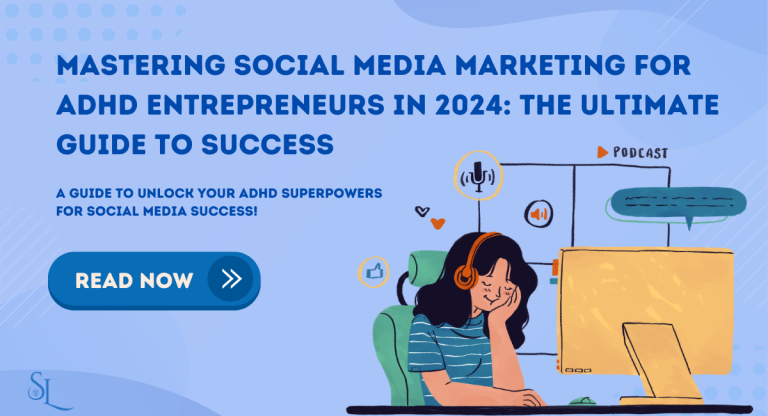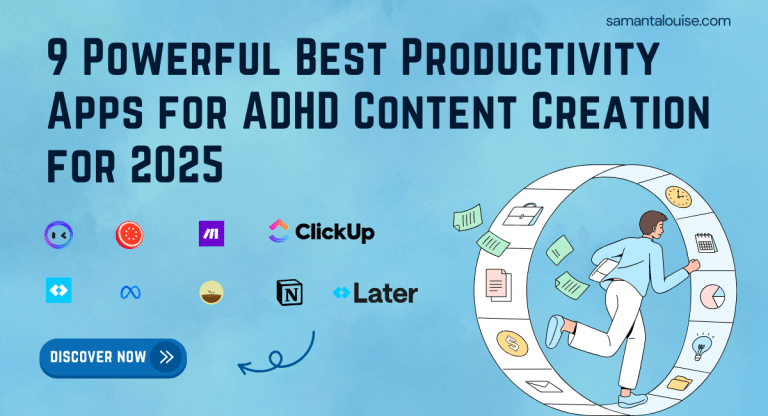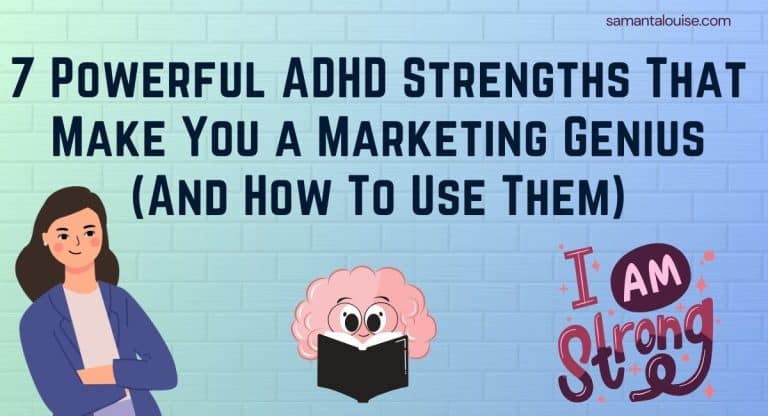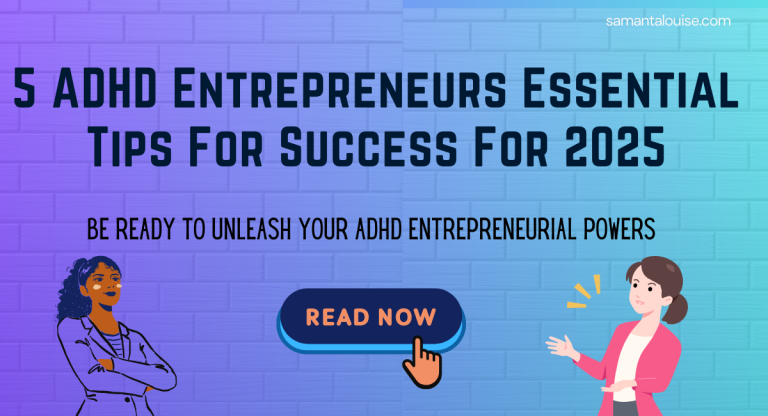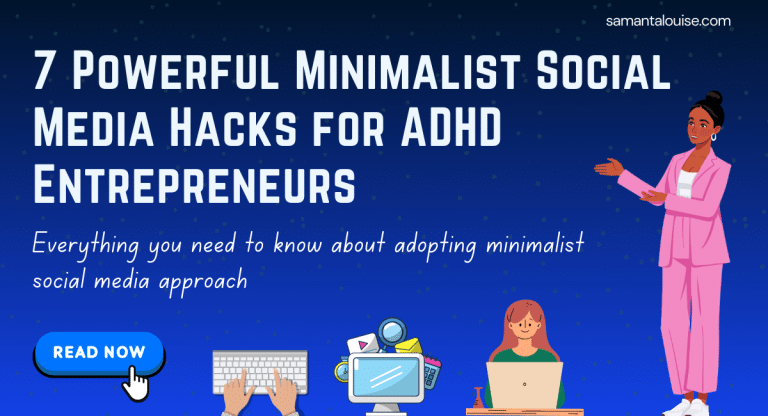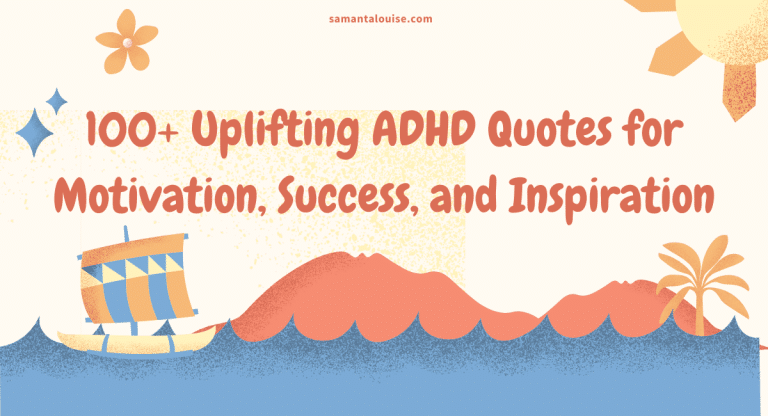7 Powerful Social Media Detox Tips for ADHD Entrepreneurs
Want to know about the biggest ADHD entrepreneur’s paradox? Here it is: social media is your marketing lifeline, yet it’s also the ultimate distraction! So, how do you pull off a social media detox when the pressure it puts on your ADHD brain feels like you are desperately swimming upstream in the Amazon River?
As a digital marketer with ADHD, I have experienced digital overwhelm first-hand and badly needed a break. However, I was always scared of the consequences of being absent from social media if I did take one. Fast forward to the present, I now have a solid plan for a social media detox to clear my mind.
Indeed, the best-case scenario is not having to take a social media break but when you have ADHD, things can be quite unpredictable and you must be ready to take the right actions. The ideal situation is to adopt an ADHD-friendly social media marketing approach optimised for your unique strengths. In this way, you can avoid the need for a digital detox.
But in this guide, we are going to focus on the best ways to do a social media detox, the benefits, how to prepare for one while having a “while-I-am-away” plan and how to successfully reintegrate work after the break.
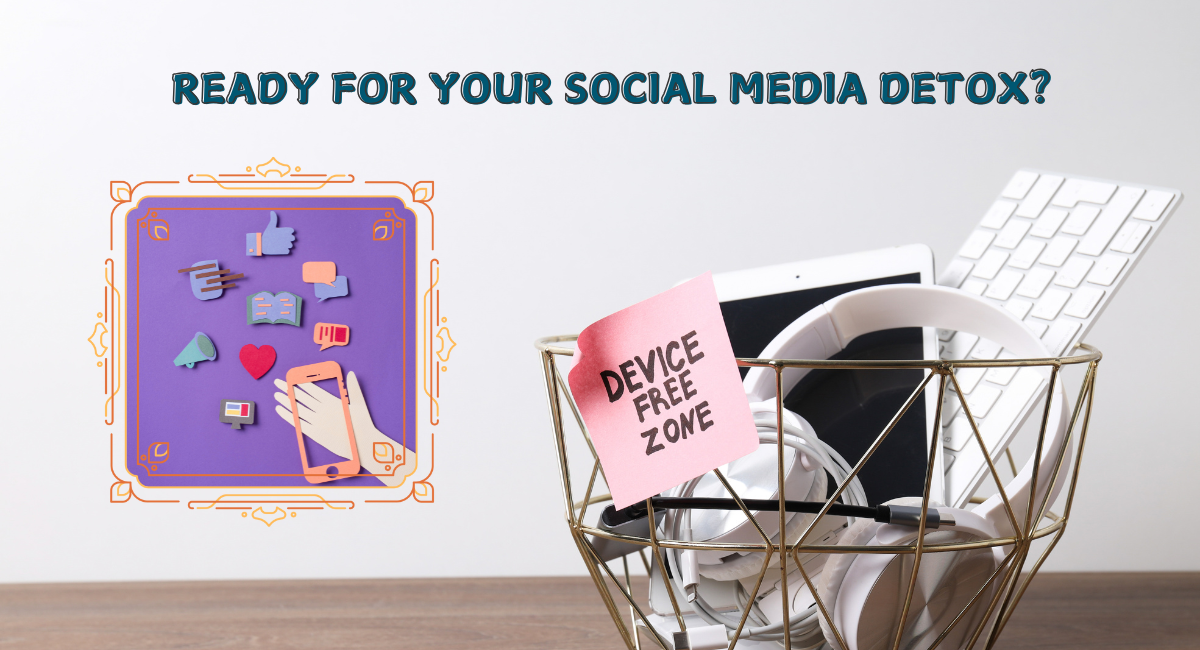
Why ADHD Entrepreneurs Need a Social Media Platforms Detox
Social media can be a major productivity killer when you have ADHD. We are especially vulnerable to its effects. Every notification, like, and comment triggers our brain’s reward system, creating an addictive cycle that’s particularly hard for us to break. Our natural tendency toward novelty-seeking behaviour makes us perfect targets for these platforms.
The dopamine-driven cycle works like this: We check social media, get a small hit of pleasure, and our ADHD brains immediately crave more. Before we know it, we’re caught in an endless loop of scrolling, checking, and refreshing. I once found myself spending three hours jumping between Instagram, Threads, and Facebook, convinced I was “networking” when I should have been working on client deliverables.
The impact on our business productivity is staggering. Try this: track your social media usage for a week… you will probably be shocked. How much time of it is associated with productive social media marketing work? Be honest with yourself. This endless cycle can be daunting over time and take a toll on your mental health.
5 Warning Signs You’re Due for a Social Media Detox
How do you know you need a break from social media? This is not something to be taken lightly, especially when you are an entrepreneur using social media to grow your business online. Here are the signs:
- You reflexively open social media apps during important tasks
- Your daily screen time report makes you wince
- You’ve missed client deadlines because of social media distractions
- You feel anxious when you can’t check your notifications
- Your most productive work happens only when your phone is in another room
If you recognize these signs, you’re not alone. The good news is that understanding how social media affects our ADHD brain is the first step toward taking control. A digital detox isn’t about completely abandoning these platforms – it’s about creating a healthier relationship with them that supports rather than sabotages our entrepreneurial success.
The Surprising Benefits of a Social Media Detox for Your ADHD Brain
When I first considered taking a break from social media, I was sceptical. I mean, wasn’t I supposed to be “always on” as a digital marketer? However after my first detox, I realised how crucial and beneficial it was to my long-term productivity. This isn’t just my personal experience – research published in Addictive Behaviors (2020) found that digital detox periods led to significant improvements in focus, productivity, and overall wellbeing. Here are some noticeable benefits of social media detox experiments:
1. Improved focus and task completion
Without the constant pings and notifications, you can finish more tasks before moving on to the next one. There will be less procrastination and last-minute panic. During my social media detox, I was able to focus more on my social media tasks and finished my work faster. If you are working on a huge project that does not require the use of social media, for instance, writing several blog posts, doing a detox is of great to cut off unnecessary distractions. More focus leads to more tasks being done.
2. Enhanced creativity and problem-solving skills
It turns out that when you’re not constantly bombarded with other people’s ideas and opinions, your own creativity has room to flourish. I found myself coming up with solutions to business challenges that had been stumping me for months. There was this one time I was stuck on how to streamline my client onboarding process. I’d been googling and scrolling through LinkedIn for answers, getting nowhere. During my detox, the solution hit me while I was out for a walk – no phone, no distractions, just me and my thoughts. It was like my brain finally had the space to connect the dots.
3. Better sleep quality and reduced anxiety
I am an insomniac and most of the time, I find myself scrolling social media posts before bed, which makes it harder to fall asleep. Let me tell you right away: scrolling social media is not “winding down”. During my detox, I rediscovered the joy of reading actual books before bed. My sleep improved dramatically, and I found myself waking up refreshed and ready to tackle the day. I was less anxious about staying “on” all the time for engagement and I felt more confident in my own path.
4. More meaningful connections and networking effectiveness
I know it sounds counterintuitive, right? But hear me out. Instead of relying on likes and comments for “networking,” I started attending local business events and reaching out for coffee meetings. The connections I made were deeper and more meaningful. I remember meeting a potential client at a local entrepreneur meetup. We hit it off, and that face-to-face interaction led to a long-term partnership that probably wouldn’t have happened through a LinkedIn message.
5. Healthier boundaries with social media use
During and after my detox, I set clear boundaries around my social media use. I now have designated times for checking and posting, and I use app blockers during my focused work hours. This approach has allowed me to enjoy the benefits of social media without letting it control my time and attention. So, if you’re feeling overwhelmed, scattered, or just plain stuck, consider giving a social media detox a try. You might be surprised at how much your ADHD brain – and your business – can thrive when given a break from the digital noise.
These social media detox benefits are worth the time and effort you put into this process to declutter your mind and increase your net productivity levels.
7 ADHD-Friendly Social Media Detox Tips That Actually Work
Despite being a digital marketer, I have implemented social media detox strategies several times to help me reduce stress, overwhelm, and other challenges associated with the use of social media. However, I have discovered that some strategies and tips do not work, so I have come up with a list of the best tips to implement if you want this phase to succeed. These ADHD-friendly tips are designed to work with our unique brain wiring.
A social media detox does not mean cutting off social media entirely, even if in some cases, this might be helpful. Instead, it means knowing when and how to use it so that it does not affect your overall well-being, performance and productivity.

1. Set a curfew time for social media use
This technique might take you back to your childhood but it is effective. This one’s all about creating a nightly ritual to wind down your digital day. Set a specific time each evening – let’s say 8 PM – when you “sunset” your devices. This means no more social media, emails, or unnecessary screen time. It is easier said than done because just deciding a curfew time will not magically cause you to turn off your devices or social media platforms.
Here’s how to make it stick:
- Use warm lighting or candles to signal your brain it’s time to wind down.
- Put your phone in a designated “sleep” spot – preferably in another room.
- Replace scrolling with a relaxing activity like reading, journaling, or light stretching.
I found this technique particularly helpful in improving my sleep quality and reducing late-night anxiety spirals. It takes some getting used to, but after a week, you’ll start looking forward to your curfew time.
2. Set a very short time for social media checks
Do you struggle with an “all or nothing” mentality? Are you the type to give up entirely just because you have broken the rule once? Imagine you’re on a diet. You eat one cookie, and instead of thinking “Okay, that was one cookie, moving on,” you think “Well, I’ve already ruined my diet, might as well eat the entire packet!” That’s all-or-nothing thinking.
This tip might work for you. The idea is simple: when you feel the urge to check social media, set a timer for two minutes. That’s all you get. Here’s why it works:
- It satisfies the dopamine craving without derailing your entire day.
- It forces you to be intentional about what you check in those two minutes.
- Over time, it reduces the overall urge to constantly check your feeds.
I was sceptical at first, but this technique helped me cut my social media time by 70% without feeling deprived. The key is to be strict with the timer – when it goes off, you’re done, no exceptions.
3. Create a no-phone zone in your workspace
This strategy is about designing your environment to support your goals. Designate specific areas in your workspace (or home) where phones and tablets are not allowed. I always remember what my mother said when I was 13 years old: “Have a shitty environment, you will get shitty results”. So you should pay more attention to your environment.
Here’s how to implement this tip:
- Create a visually appealing “phone parking station” at the entrance of your no-phone zone.
- Use visual cues like signs or colored tape to remind you of the boundaries.
- Start small – maybe just your desk area – and gradually expand.
I found this incredibly helpful in maintaining focus during work hours. It’s amazing how much more you can accomplish when your phone isn’t within arm’s reach. It makes sense, right?
4. Use the Pomodoro Technique
You’ve probably heard of the Pomodoro Technique – I have written a lot about this game-changing method. I created its ADHD-friendly twist specifically for managing social media use:
- Work for 25 minutes with zero social media access.
- Take a 5-minute break where you’re allowed to check social media for a few minutes.
- After four cycles, take a longer 15-30 minute break that allows you to use social media for a longer period.
However, my best advice is to eliminate the use of social media platforms during these sessions. I have found myself scrolling past my set time far too many times. I have discovered that time-blocking techniques can help in enhancing this method and increase productivity.
The beauty of this method is that it gives you something to look forward to, satisfying our need for immediate rewards. Plus, it helps train your brain to focus for longer periods.
5. Use app blockers and set screen time limits
Technology can be both our downfall and our savior. Use it to your advantage with app blockers and screen time limits. Can you trust yourself to stay away from your highly addictive social media accounts when required? I cannot, which is why I rely on app blockers and set screen time limits to help me out.
Apps like Forest, Focus To-Do or built-in phone features can be powerful allies. Here are some tips for success:
- Set up blockers during your most productive hours.
- Use the “locked” mode where you can’t override the settings easily.
- Gradually increase the blocked time as you build your “focus muscle.”
I use Focus To-Do on my phone when I go into “focus mode” because it prevents me from having my phone facing up, else it resets the timer. Another crucial element is to track your social media time and set limits on your phone. I was amazed at how much time I was actually spending on social media once I started tracking it. These tools provide concrete data that can be a real wake-up call.
6. Find an accountability partner during your social media detox phase
Find an accountability partner – ideally another ADHD entrepreneur who gets the struggle. Set mutual goals and check in regularly. If you can find someone in your immediate environment who can monitor your actions, that is even better. You can let that person know of your intentions to use social media less and have them remind you each time you drift away from your goals.
Here’s how it works:
- Share your social media usage goals with each other.
- Have daily or weekly check-ins to discuss progress and challenges.
- Celebrate wins together and problem-solve when facing setbacks.
This strategy taps into our ADHD tendency to perform better when we feel accountable to others. Plus, it adds a social element that can help replace some of what we miss from social media. You could try doing other activities with your partner such as playing board games or practicing some mindfulness exercises.
7. Replace the scroll time with a productive activity
If you want to have a productive social media detox time, replace your bad habits with good ones. There are many ways you could do this such as using the time to jot down ideas on a notebook, learn something new or meditate to improve focus.
Here is why it is an effective strategy:
- It redirects your brain’s need for stimulation to something productive.
- Over time, you build a valuable repository of business ideas.
- It helps train your brain to associate downtime with creativity rather than passive consumption.
I’ve generated some of my best business ideas using this method. It turns what used to be wasted time into a valuable ideation session. If you do not want to use that time to do something business-related, you can do something you love. For me, I use the time to learn Chinese or take byte-sized statistics lessons on Nibble.
Quick-Start Guide: Your First 24 Hours of Digital Detox
Once you have decided to do a social media detox, here’s to kick it off:
1. The night before:
- Announce your detox on social media (ironic, I know, but it helps with accountability).
- Set up app blockers on your devices
- Install apps to help you navigate your social media detox phase successfully for example Focus To-Do
2. Morning:
- Wake up with a non-phone alarm clock (Traditional methods work!)
- Instead of checking your social media accounts, do a quick journaling session or meditation
- Eat breakfast without any screens present
3. Workday:
- Use the Pomodoro technique to structure your work.
- When you feel the urge to check social media, do a quick physical activity instead (jumping jacks, anyone?).
- Use social media only for work-related purposes – if you have to do some marketing – treat it as a platform for work not leisure platform
4. Evening
- Respect your curfew time – it should ideally start 2 hours before your bedtime
- Reflect on how the day felt without social media
- Plan a rewarding activity for tomorrow to look forward to
- Note down any relapse during the day if there are any.
The goal isn’t perfection. It’s about creating new habits and giving your ADHD brain a chance to reset. Be kind to yourself, celebrate small wins, and stay committed to the process. You’ve got this!
How to Prepare Your Business for a Social Media Break
Pulling off a social media detox is not an easy feat and preparation is key. This reminds me of the famous quote in Steven Covey’s book “The 7 Habits of Highly Effective People” which goes “”If I had eight hours to chop down a tree, I’d spend six hours sharpening my axe.”
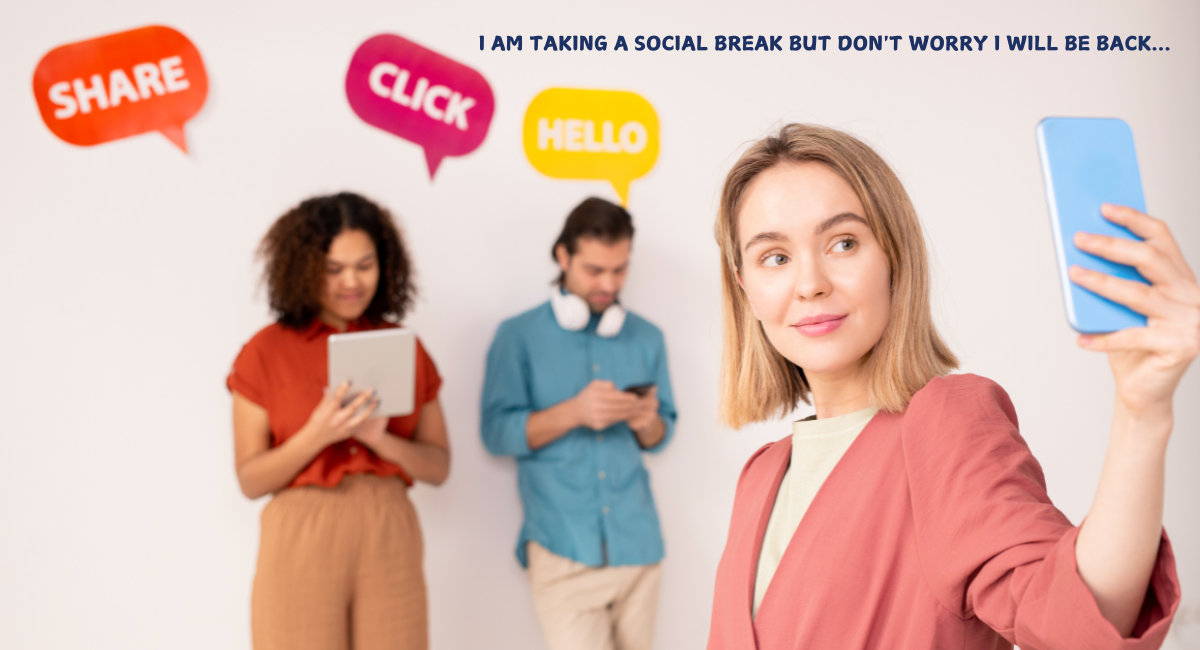
With the right preparation, you can complete your digital detox successfully. You should not hesitate to do some social media detox research before you get started. But here are the things I usually do to guarantee success:
1. Conduct a social media audit
You need to know what you are working with first. Here’s your step-bystep audit process:
Step 1: Assess your platforms
- List all your active social media accounts
- Track engagement rates for the last 3 months
- Identify which platforms drive actual business results
- Note which tasks are essential vs. optional
Step 2: Review your content’s performance
- Document your top-performing posts
- Analyze posting times and frequency
- Review audience demographics
- Calculate ROI for paid campaigns
By performing this audit, you will be in a better place to make decisions on what needs to be done while you are away.
2. Set up content scheduling and automation
Like I said before, a social media detox does not mean you disappear completely from social media. Here’s how to maintain engagement:
Step 1: Plan your social media calendar
- Batch create 2-3 weeks of content (Learn my top social media batching techniques here)
- Include a mix of evergreen and timely posts
- Plan engagement-focused content that doesn’t require immediate responses
Step 2: Set up automations
- Schedule posts using tools like Later or native schedulers
- Set up auto-responders for DMs using ManyChat
- Create FAQ response templates
- Configure cross-platform sharing
3. Communicate your detox to clients and followers
Not telling your followers and clients is unprofessional. You need to be clear on one thing: you are not trying to run away from work. Rather, you are creating room for more productivity and creativity to do a better job. Transparency is key.
- Send personalized emails to key clients
- Provide alternative contact methods
- Set clear expectations for response times
- Highlight benefits of your increased focus
Creating a Foolproof Emergency Contact System
Finally, you cannot vanish if you have important business on social media. Remaining available while setting clear boundaries during the social media detox is key. You need to have a system in place for this, here’s mine:
- Listing down scenarios that qualify as urgent
- Creating response protocols for each
- Documenting decision-making criteria
- Designating a primary contact person
- Setting up emergency-only communication channels
- Briefing my team on procedures
- Scheduling check-in points
Pro Tip: Create a simple flowchart for your team or VA to handle incoming messages while you’re away. This ensures nothing crucial falls through the cracks while maintaining your boundaries.If you do not have a team, you can use AI or automation to help you out while you are away.
Take the time to set these up properly, and you’ll be amazed at how well your business can function without constant social media monitoring. This comprehensive preparation will give you the peace of mind to fully engage in your digital detox while keeping your business running smoothly.
Maintaining Business Momentum During Your Detox
Think of your social media detox as an opportunity to strengthen other aspects of your business. Here’s how to keep growing while you’re offline:
1. Shift your focus to SEO and content creation
This is your chance to create engaging content and build lasting organic traffic if you own a website. Create content for all your social media accounts in batch and focus on evergreen content. You can also conduct keyword research and do a brand audit for a makeover. You can download my organic marketing ebooks to learn more on personal branding, content marketing, social media influence and copywriting.
2. Leverage email marketing for client engagement
Your email list is your primary communication channel during a social media detox. You can use it to do a sales or marketing campaign for your client . You can develop valuable lead magnets and start a newsletter for your subcribers. You can use it as an engagement booster by sharing exclusive content, run subsriber-only promotions or ask for feeback and responses to learn more about your audience.
3. Explore offline marketing opportunities
You can use this time to get creative with traditional marketing and explore the options you have to promote your business through these channels. You could do some local networking by going to chamber of commerce events or any events supporting entrepreneurs. You could also do some direct marketing by sharing your business card and doing some local advertising.
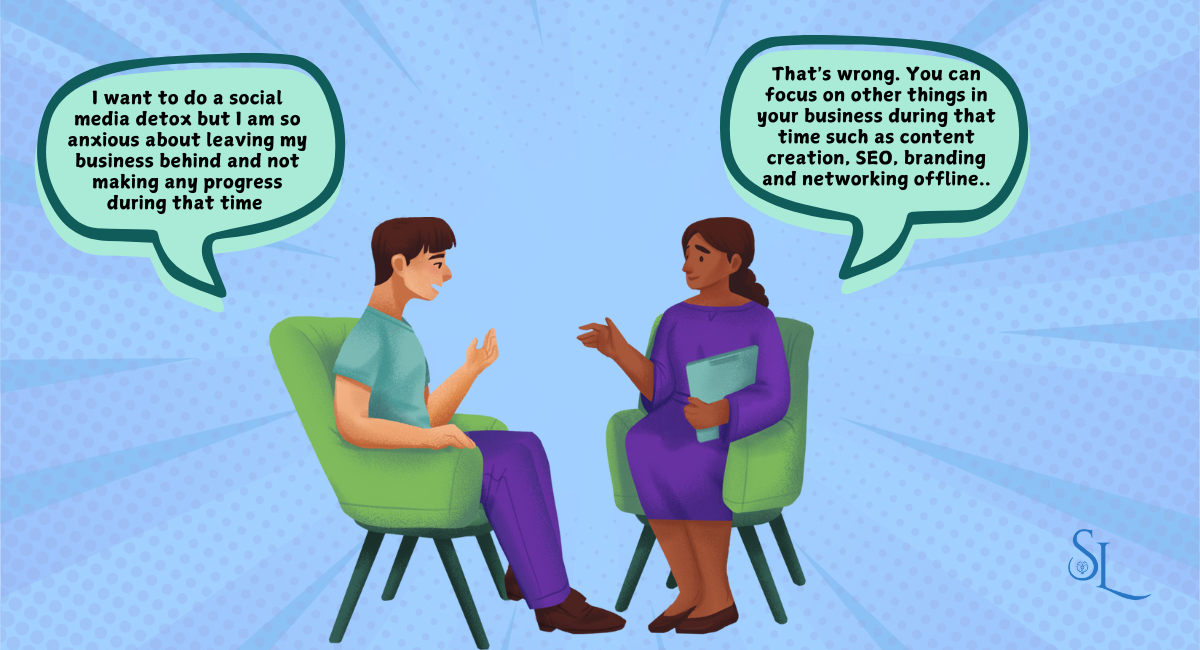
The Post-Detox Action Plan: Reintegrating Social Media Mindfully
What to do after your detox? You should not jump to social media and spend a day catching up on what you have missed. Instead you should reintegrate gradually. Here is how to do it:
1. Do This In Your First Week Back
- Set specific usage times
- Choose priority platforms
- Install tracking tools
- Define success metrics
- Schedule regular breaks
2. Set Boundaries
- Choose offline hours
- Set notification rules
- Create response guidelines
- Plan regular detox days
- Document lessons learned
3. Review Your Analytics
- Check your social media analytics for when you were gone
- Check if your automations worked well
- Define success metrics
- Prepare a new plan for upcoming weeks based on success/failure
ADHD-Friendly Apps and Tools for a Successful Digital Detox
If you are having a hard time implementing a digital detox, you should use helpful tools and apps to help you out. Here are some tools I use actively:
1. Focus Apps
You can use tools like Focus To-Do for Pomodoro sessions. It will prevent you from turning your phone up when you are in a session and also provides detailed analytics on the duration of your focus sessions. You can use Forest on your Chrome browser as an extension to help you focus and complete tasks. It is a Pomodoro timer which is highly effective.
2. Productivity Tools
You can use task management apps like Notion and Clickup to centralise your list of tasks and note down the important steps to take for completing a task. The importance is to have a visual representation of your tasks and their progress to reference to.
3. Automation Tools
You can use automation to do your tasks whilst you are away. For instance, publishing posts for you across multiple social media platforms. You can use a scheduling tool like Later or Meta Business Suite. One of my favorite automation tools is Make. It allows me to use AI in the content creation process and simplify my work.
You also can read my article on the 19 Best Social Media tools For ADHD Entrepreneurs in 2025. I go more in details on each tools, their benefits and what they do to make your life easier when doing social media marketing.
Final words
I hope this was a helpful article to you and wish you the best in completing your social media detox. If you want similar tips, subscribe to my newsletter. And always remember that Embarking on a social media detox doesn’t mean abandoning your online presence – it’s about reclaiming control and using these platforms intentionally.
As an ADHD entrepreneur, you have the power to transform your relationship with social media, boosting both your well-being and your business success. You can start with a 7-day social media detox journey to see how it feels for you initially.
Start with one strategy today, and watch as your focus, creativity, and productivity soar.

